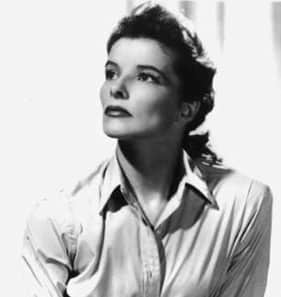Kathrine Hepburn, the winner of more acting awards than any other actress in history, is a very dynamic woman. She was born in Hartford Connecticut, on May 12, 1907. She was the second oldest child of six. Kate,as she was called by her family members, had two sisters, Peg and Marion, and three brothers, Tom, Dick, and Bob. She attended Bryn Mawr college in Connecticut. She majored in acting. During her senior year at Bryn Mawr, Katharine met Ludlow Odgen Smith.
That was 1927. In 1928, she and “Luddy” (her nickname for him) were married. They moved from Hartford to New York. Kate’s acting career started in 1928 when she played in a New York Production of The Big Pond. The first Broadway production she played in was The Night Hostess where she had a small role. Miss Hepburn played a part as a schoolgirl in the play These Days. It opened in her hometown, Hartford, Connecticut. She was praised by critics for her performance. She earned a one hundred twenty-five dollar a week salary for These Days. In the 1930’s, that was a very high salary for beginning actresses.
career started in 1928 when she played in a New York Production of The Big Pond. The first Broadway production she played in was The Night Hostess where she had a small role. Miss Hepburn played a part as a schoolgirl in the play These Days. It opened in her hometown, Hartford, Connecticut. She was praised by critics for her performance. She earned a one hundred twenty-five dollar a week salary for These Days. In the 1930’s, that was a very high salary for beginning actresses.
Katharine served as Hope Williams’ understudy in Holiday. She sat through every performance for six months. One day at understudy rehearsal, Arthur Hopkins, the director, watched her act. “Fine,” he said, “Just don’t ever be sorry for yourself.” One night at midnight, Philip Barry, the writer of the play, asked her if she still knew her part. Hope was sick and they needed her to perform. She spent all day the next day memorizing her lines. Katharine did her best. “I lived through it … so did the cast.” She did have one disappointment. Arthur Hopkins didn’t come to watch her perform. In the spring of 1930, Kate played roles in the plays The Admirable Crichton and The Romantic Young Lady. During the second week of The Romantic Young Lady, Katharine quite. She thought that she was wasting her time. She wanted a decent part. Kate and Luddy spent the rest jof the summer in Fenwick. There was a long drought of jobs in the fall of 1930.
Then Clifford Brooke, a director, sent for her to read a part for him. He and his staff had seen her in These Days. She went to the reading in old clothes. She wore no make-up except for bright, red lipstick. Benn Levy, an English producer was not used to this way of auditioning. Jane Cowl, the star of the play, took her to the make-up room and made her look beautiful. Levy still didn’t like what he saw and let her go. Katharine knew that they would regret letting her go. She was right. They called her a week later and said they would pay her one hundred fifty dollars per week to do a play called Art and Mrs. Bottle. She and Jane Cowl became good friends. Jane helped her immensely with her acting. In 1932, she appeared in a play called The Warriors Husband.
A representative from RKO Studios came to see the play. He gave her a contract. She made three movies in less than year: Bill of Divorcement, Christopher Strong, and Morning Glory. She won her first ever Academy Award in 1933 for her performances in these movies. In late 1933, Kate made Little Women. This was one of her favorite movies. Then, in 1934, she made a picture called Spitfire. Between 1936 and 1938, she made eight movies. She thought that four of them were very dull. The other four, she thought, were good movies, two with Cary Grant. She did Holiday on a loan-out from RKO Studios, who wanted rid of her. They made a deal: She paid RKO $75,000 and they would let her do Holiday for Columbia, who had offered her 150,000.
The 1940 MGM film version of The Philadelphia Story, which she did with Cary Grant, brought her a New York Film Critics’ Circle Award. In 1942, she made Woman of the Year. This was the first of many popular films that she made with her friend, Spencer Tracy. Other movies that she made with him were Keeper of the Flame, Without Love, Pat and Mike, and Desk Set. She won a Carnes Film Festival award for Guess Who’s Coming to Dinner, which was Spencer’s last film. Kate also won an Academy award for it. She was nominated for six Oscars and won three of them. Katharine, a dedicated individualist, added her dynamic personality to many early movies. That is what made her a living legend.

Jimmy Hagen didn’t write Holiday. Philip Barry did.